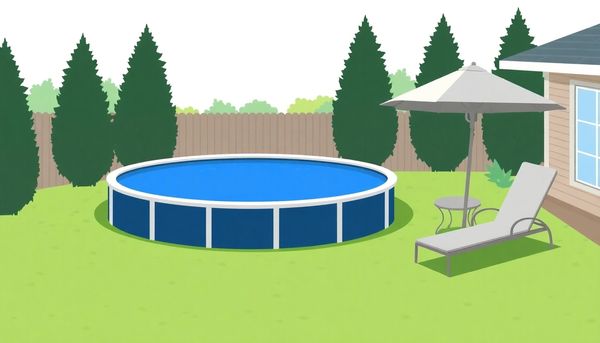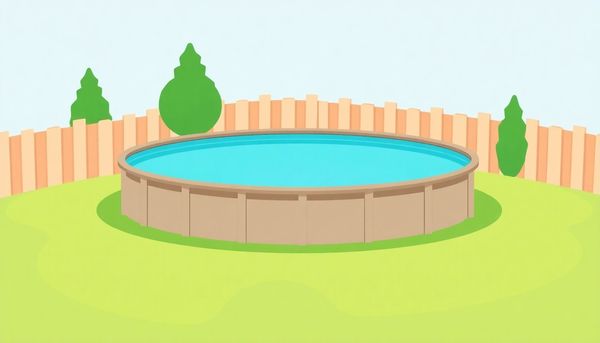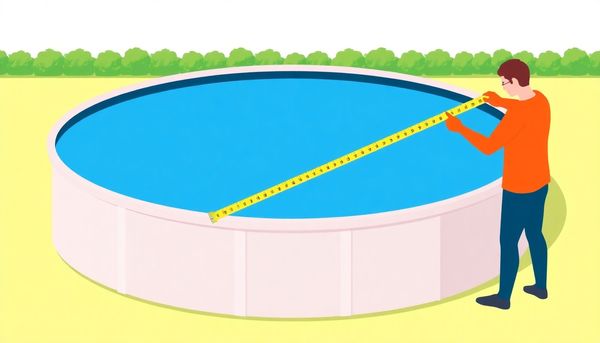Choosing the Perfect Above Ground Pool Liner: A Comprehensive Guide
April 08th, 2024
April 08th, 2024
A shimmering oasis in your backyard—the allure of an above ground pool is undeniable. It's a sanctuary for laughter-filled cannonballs, tranquil float sessions, and the occasional impromptu pool party. For those who have embraced the joys of owning such a pool, the importance of its liner cannot be overstated. This seemingly simple component serves as both protector and aesthetic enhancer, playing a crucial role in maintaining the pool’s integrity and visual appeal.
Recall the time you spent a Saturday afternoon replacing a liner, only to find it slightly off-center, leading to weeks of tiny leaks and wasted water. Such experiences highlight how critical it is to select the right liner tailored to your pool’s size, shape, and usage patterns. The market offers an array of options, from sturdy vinyl choices to intricately designed patterns that mimic the appearance of a tiled pool. However, choosing the perfect liner involves more than just picking a color that matches your garden furniture.
Exploring the world of pool liners, one discovers the nuances involved in selecting the right thickness and material that will withstand the elements and years of splashing. Whether you're a first-time pool owner or a seasoned backyard swimmer, understanding the ins and outs of pool liners ensures a longer-lasting and more enjoyable swimming experience. In this guide, we delve into everything you need to know, helping you make informed decisions and avoid common pitfalls.

Standing under the blazing summer sun, you glance at your worn-out above ground pool liner and decide it's finally time for a change. Opting for the right liner isn't just about picking a pretty pattern; it’s about ensuring durability, ease of maintenance, and compatibility with your existing pool setup. Your first decision revolves around the type of liner. Overlap liners, though budget-friendly, require precision during installation to avoid wrinkles and misfits. If convenience is your priority, consider a J-hook liner, which offers a simpler installation process without the need for coping strips.
For those seeking versatility, the unibead liner is an innovative choice. Its adaptable design allows it to be fitted in either a beaded track or as a J-hook, providing flexibility if you ever decide to change your pool structure in the future. When selecting a liner, thickness is crucial. Aim for a liner with a higher mil count for added durability, but remember that overly thick liners can be tricky to install and may wrinkle if not handled properly.
Lastly, consider the climate in your area. If you live where the sun can be harsh, liners treated for UV resistance can prolong your liner's life. And don’t forget a good liner pad—it’s like a cozy blanket that protects against punctures and uncomfortable lumps. Choosing the right liner might seem like a maze initially, but with a little knowledge, you’ll find the perfect fit for your pool and be back to enjoying those sunny, splash-filled days.
Tucked away in your backyard, your above ground pool beckons with promises of summer fun, but understanding the types of liners available is crucial when the time comes to refresh its look. Each liner type has its unique characteristics and installation requirements, and knowing them can make all the difference in longevity and maintenance.
Overlap liners are the budget-friendly choice. They drape over the pool's walls, held securely by coping strips. While they might present a bit of a challenge during installation, they are a go-to for many due to their cost-effectiveness. I remember a friend who tackled this with a little trial and error, realizing that an extra pair of hands made securing the coping strips a breeze.
For those seeking a quicker setup, J-hook liners offer simplicity. These liners come with a built-in hook that seamlessly slides over the pool's edge, eliminating the need for additional clips. A neighbor once recounted how this liner saved him time and frustration—ideal for those who prefer a hassle-free installation.
Unibead liners represent versatility, adapting to both J-hook and beaded tracks by simply trimming the top portion. A true chameleon, this liner fits almost any setup, making it a popular choice for those who enjoy flexibility without being tied to one style.
Finally, the beaded liners snap into place using a dedicated track, giving your pool a polished appearance. Conversion kits allow overlap setups to switch to this sophisticated option, perfect for those upgrading their pool's aesthetic. Understanding these liner types not only helps in selecting the right one but also ensures your aquatic oasis remains a source of joy for years to come.
Staring at a pool liner that looks more like a quilted patchwork than a smooth surface isn't ideal, and yet, it happens more often than you'd think. Navigating the world of above ground pool liners can be tricky, but avoiding common pitfalls can save you time and money. The first mistake to sidestep is choosing the wrong liner thickness. While it might seem like more is better, a thicker liner can be challenging to install and more prone to wrinkling if not fitted properly. Instead, focus on the liner's mil measurement rather than gauge to ensure you’re getting a robust, fit-for-purpose product.
Next, don’t underestimate the importance of proper chemical balance. Excessive chlorine can degrade your liner, making it brittle and prone to tears. I recall a friend who thought more chlorine meant cleaner water, only for their pool liner to start cracking within a season. Regular testing and adjusting of pool water chemistry will keep your liner healthy and extend its lifespan.
Finally, consider your environment. If your pool is exposed to harsh sunlight, think about investing in a UV-resistant liner or covering the pool when not in use. Also, be cautious when mowing the lawn or doing yard work; small stones hurled by a mower can puncture the liner, creating leaks that are both frustrating and difficult to locate. By steering clear of these common errors, you can ensure your pool liner remains in top shape.
Caring for your pool liner isn't just about avoiding the hassle of replacement; it's about preserving the heart of your backyard oasis. Think of it as nurturing a plant. A little attention goes a long way in keeping your pool liner healthy and vibrant.
Start with the basics: regular cleaning. Use a soft-bristle brush to gently scrub away any algae or debris clinging to the vinyl's surface. It's akin to giving your pool a gentle massage, ensuring that nothing unwanted takes root. Make it a routine, and your pool liner will thank you with a longer life.
Now, consider the chemistry. Maintaining balanced pool water is like crafting the perfect recipe. Too much of any chemical, especially chlorine, can weaken the liner, leading to premature wear and tear. Invest in a reliable test kit and check pH levels, alkalinity, and sanitizer levels frequently. Your liner will respond well to such considerate treatment.
Don’t forget the sun. Just as you wouldn’t leave a book out in the rain, avoid extended UV exposure to parts of the liner above the water. A solar cover can protect it from the harshest rays, keeping it flexible and less prone to cracking.
Lastly, when closing your pool for the season, ensure it's properly winterized. An above-ground pool cover shields the liner from the elements, much like a cozy blanket guards against the winter chill. Each step you take in maintaining your pool liner adds up to more summers of worry-free, splashing fun.

Stepping out to find your pool liner resembling a patchwork quilt of repairs is frustrating, yet all too common. To avoid reaching this point prematurely, giving your liner some TLC can make a significant difference. Let’s chat about some practical strategies to extend the life of your pool liner and keep it looking its best.
First, think of the sun as both friend and foe. While it warms your pool for a pleasant swim, those intense UV rays can bleach and dry out the exposed parts of your liner. Consider using a pool cover when not in use, or strategically planting some shade-giving trees or shrubs that add a touch of nature while shielding your pool. Not only does this guard against sun damage, but it also helps retain water temperature and reduce evaporation.
Now, let’s discuss chemicals. A balanced pool isn’t just safer and more pleasant to swim in, it protects your liner too. Excessive chlorine can be as harmful as too little, leading to weakening and rapid wear. Regular water testing ensures you’re adding just the right amount; invest in a reliable test kit and use it as routinely as you drink your morning coffee.
Finally, be mindful of your surroundings. A small stone flung from a lawnmower or a branch broken in a storm can spell disaster for your liner. Regularly clear debris around the pool area and secure loose branches or ornaments that could cause damage.
By incorporating these habits, you’re not just protecting your investment, you’re setting the stage for countless summers of fun and relaxation without the nagging worry of liner emergencies.
Selecting the perfect liner for your above ground pool can feel like navigating a maze, but with a little guidance, it's as simple as a summer breeze. The first step is to understand your pool's needs. Hard-sided pools typically require liners that are less heavy-duty than those for soft-sided pools, thanks to the support provided by the pool walls. However, this also means they can be more susceptible to damage from the elements.
Consider the type of liner that suits your installation method. Overlap liners, while economical, can be a bit tricky to secure. Beaded liners, on the other hand, offer a more polished look and are easier to install, especially if you plan to use a conversion kit. J-hook liners provide a straightforward setup without the need for additional tools, making them a popular choice for pool owners looking for simplicity.
Don't overlook the material and thickness of the liner. Measured in mils, a thicker liner can offer more durability but may also come with installation challenges. Balancing thickness with ease of installation is key. Brands like Intex or Kayak might have specific requirements, so checking compatibility with your pool model can save you from potential headaches down the road.
Lastly, always pair your liner with a quality liner pad. This simple step helps prevent punctures and prolongs the life of your liner, ensuring many more summers of splash-filled fun. With the right liner, your pool becomes a haven of relaxation and enjoyment, solidifying its place as the centerpiece of your backyard retreat.
Sunlight and chemicals—two silent culprits that can stealthily undermine your pool liner’s integrity. The blazing sun, a staple companion of pool days, doesn’t just warm the waters. Over time, those ultraviolet rays can bleach your liner, making it look faded and tired. More worryingly, prolonged exposure leaves the liner dry and brittle, especially at the waterline where it’s most vulnerable. It’s akin to leaving a pair of rubber boots outside for a season; eventually, they crack.
On the other hand, your pool’s chemical balance is not just about keeping the water safe and clear. An overload of chlorine, for instance, can slowly eat away at the liner, making it fragile. You wouldn’t wash your delicates with bleach; a similar gentle touch is needed here. Maintaining balanced water chemistry is crucial, not just for swimmers, but for the liner’s longevity too.
Consider setting up a shade structure or using a pool cover when the pool is not in use. It’s like giving your liner a protective umbrella. Regular water testing and adjustments will keep chemical levels in check, ensuring they’re just enough to keep the pool pristine without harming the liner. By taking these proactive steps, you not only guard against premature wear but also prolong your pool’s vibrant summers.
In the ever-changing world of pool maintenance, keeping the right balance in your pool's chemistry is like fine-tuning an orchestra. Each element plays its role, and when everything is in harmony, your above ground pool liner will sing—a symphony of summer fun without a hitch. The importance of maintaining pool chemistry might not be as obvious as the thrill of a new liner, but rest assured, it's vital for its longevity.
Think of chlorine as your pool's vigilant guardian. While it tackles bacteria and algae, too much can be a double-edged sword, weakening your liner over time. Balancing chlorine levels akin to following a recipe—you need just the right amount for everything to come out perfectly. Personally, I remember when my own pool transformed into a chemical cocktail, leading to a brittle, faded liner. A quick review of chemical levels quickly set things straight.
pH levels are another key player in this balancing act. Ideally, you want to keep your pool’s pH between 7.2 and 7.8. This range helps protect the liner from scaling or corrosion while ensuring a comfortable swim. Total alkalinity, too, shouldn’t be overlooked—it should hover between 80 and 120 ppm to keep pH levels stable.
Regular testing and adjustments are your best friends. Investment in a quality test kit can save you from costly liner replacements down the road. Keeping an eye on your pool’s chemistry isn't just about a clear swim; it’s about ensuring your liner enjoys a long, healthy life.

Faced with the sight of your pool liner resembling a quilt of mismatched patches, you might wonder how to prolong the life of your next liner. Enhancing liner durability isn't just about choosing the right material; it's about a few smart practices that can save you a lot of hassle (and patches) down the line.
Start by considering the sun, an ally for pleasant swims but a foe to your liner. The relentless UV rays can weaken the vinyl, causing fading and brittleness. A simple, effective step is to invest in a pool cover, which serves as a shield against the sun’s harshness. Not only will this prevent bleaching, but it will also keep debris at bay, reducing the risk of punctures from small twigs or other flying objects.
Next, think about water chemistry. While chlorine is essential for keeping your pool sparkling clean, excessive amounts can deteriorate the liner. Regularly test the water and maintain balanced chemical levels to ensure the longevity of your liner. It's akin to adding just enough salt in a recipe: too little, and the dish is bland; too much, and it’s ruined.
Lastly, take a cue from how you handle the yard. When mowing the lawn, aim the chute away from the pool. Even the smallest stone can wreak havoc on a liner. And for those living in storm-prone areas, regularly inspect the surroundings for tree limbs that might become projectiles during high winds. Each of these steps is a stitch in time, preventing nine (or more) repairs later.
#

Choosing the right liner for your above-ground pool can feel akin to picking the perfect pair of shoes—functionality, style, and fit all matter. Each liner type has its unique advantages, and finding the one that suits your pool can significantly affect its durability and your swimming experience.
Consider the overlap liner, which is the budget-friendly candidate of the bunch. It folds over the pool’s edge and is secured with coping strips. While it might test your patience during installation, it rewards you with a lower price tag. My neighbor, for example, chose this option because it allowed them to reallocate funds towards a fancy poolside umbrella.
If convenience is your priority, the J-hook liner may just be your match. With its easy slip-on design, it eliminates the need for coping strips, making installation a breeze. It’s like upgrading from those sneakers with laces to a pair of slip-ons—less hassle, more enjoyment.
Next, we have the beaded liners that click into a track at the top of the pool wall. This style, while slightly more expensive, offers a polished look and is easier to replace or remove if needed. My brother swears by these, noting how the installation kit made the task a weekend project rather than an all-day affair.
Lastly, the unibead or universal liner offers flexibility, adapting to either J-hook or beaded setups. Think of it as the convertible of pool liners—one product with multiple uses. Whatever your choice, ensure it complements your pool’s setup and your personal style for many summers of enjoyment.
Finding your pool liner faded and brittle after a sunny season can be a harsh reminder of the power of nature. Above ground pool liners, much like our skin, need protection from the sun's relentless ultraviolet (UV) rays. These rays can bleach colors and weaken the areas above the waterline, eventually leading to cracking and tears. This natural aging process can be slowed by using a protective cover when the pool is not in use, effectively shielding it from the sun’s harshest effects.
Weather, too, can be a formidable adversary. Windstorms might unleash debris that could puncture your liner, while extreme temperature changes can cause the vinyl to expand and contract. Over time, this constant movement creates weak spots susceptible to damage. Installing a robust liner pad can offer extra protection, acting as a buffer against sharp objects and uneven ground beneath your pool, while also cushioning the liner against environmental stressors.
But what about those sudden thunderstorms or the odd hail? Keeping a vigilant eye on the weather forecast and covering your pool during severe conditions can prevent unforeseen damage. Regular maintenance routines, such as checking for and patching minor tears promptly, will further extend your liner’s life. By staying proactive, you’re not just prolonging the life of the liner, but also preserving the sanctity of countless summer afternoons spent in your pool.
Balancing pool chemistry is akin to maintaining a harmonious relationship; it requires attention and understanding. Just last summer, my friend Sarah learned this the hard way. She had overlooked her pool’s chemical balance, thinking a splash of this and a dash of that would suffice. Unfortunately, her liner didn’t appreciate this casual approach. It began to lose its vibrancy, and tiny cracks started appearing like unwelcome guests.
The key to avoiding Sarah's fate lies in regular testing and adjustments. The pH levels, for instance, should always hover between 7.4 and 7.6. This range not only protects the liner but also keeps the water gentle on swimmers' skin. Then there’s the chlorine—it’s essential for keeping the pool sanitized, but too much can lead to discoloration and brittleness in the liner. A concentration of 1 to 3 ppm is generally ideal.
Alkalinity is another crucial factor. It acts as a buffer for the pH level, with the sweet spot being between 80 and 120 ppm. Fluctuations can lead to corrosive water, which can damage your liner over time. On top of the standard tests, check cyanuric acid levels to protect chlorine stability, especially if your pool gets a lot of sun exposure.
Regular maintenance doesn’t just ensure a longer life for your pool liner; it also means more time spent enjoying a pristine pool rather than dealing with costly repairs.

The day arrives when your once pristine above ground pool liner now resembles a patchwork quilt, but not in an endearing way. With a sigh and perhaps a hint of excitement for the fresh look, it's time to bid farewell to the old and usher in a new liner. Mastering the installation of your above ground pool liner hinges on a blend of preparation, precision, and patience.
Begin by gathering your tools: utility knife, shop-vac, duct tape, and maybe a helping hand or two; teamwork is your ally here. Start by carefully removing the old liner. This involves cutting it into manageable pieces and gently detaching it. Once the liner is out, assess the sand or dirt base beneath. Spread a fresh layer of sand, ensuring it's smooth and compact. This foundational step is crucial for a wrinkle-free liner finish.
Next, lay down a high-quality liner pad, safeguarding against sharp objects and unevenness. Some may scoff at this extra step, but consider it a worthwhile insurance against future tears. With the pad in place, position your new liner, aligning it with the pool walls. Slowly and meticulously, secure it in place according to its specific style—overlap, beaded, J-hook, or unibead.
A vacuum will be your secret weapon to eliminate air pockets, smoothing the surface like a pro. As the liner settles, start filling the pool with water, allowing you to simultaneously reattach the top rails and fittings. With everything in place, step back, admire your handiwork, and prepare for a summer of carefree swims and sunlit splashes.
The moment you realize your above ground pool liner is less a barrier and more a jigsaw puzzle of patches is a sign: it's time for a change. Selecting the right liner isn't just about picking the first option that pops up online; it’s about understanding your pool’s specific needs and the qualities of the liner that match them.
Consider the liner style first. Overlap liners, while budget-friendly, demand meticulous installation to avoid unsightly wrinkles. On the other hand, the snap bead or standard bead liners slip into a track, offering a smoother finish but require a conversion kit if your pool initially came with an overlap setup. J-hook liners present a middle-ground, easy to install without extra tools, providing convenience without compromising on durability.
Next, think about the liner’s thickness. Measured in mils—a thousandth of an inch—thicker liners generally promise greater durability. However, they might be more cumbersome to handle during installation. For most pools, a 20 or 25 mil liner strikes the right balance between toughness and ease of use.
Remember, your pool’s lifespan greatly depends on how well you prepare the foundation. A high-quality liner pad not only cushions but shields your liner from potential punctures or shifts in the ground. Choose between foam or geotextile pads based on your comfort preferences and environmental conditions.
Finally, always account for your pool’s specific brand requirements. Brands like Kayak or Esther Williams may have unique designs necessitating compatible liners, so double-check measurements and specifications before making a purchase. Investing in the right liner will not only revitalize your pool but also extend those cherished summer afternoons spent poolside.
The day you notice your above ground pool turning into a patchwork of repairs is a reminder that pool liners, much like your cherished possessions, require care to live their fullest lives. By adopting a few mindful habits, you can prolong the life of your liner and save yourself from frequent replacements.
Start by considering the sun, which is both a friend and foe. While it warms the water to a delightful swimming temperature, it also harbors UV rays capable of bleaching and weakening the liner material. To combat this, invest in a quality pool cover to shield the liner from relentless sun exposure when the pool isn't in use.
Balance your pool chemistry like a chef perfecting a recipe. A dash too much chlorine can do more harm than good, gradually eating away at the liner. Regularly test and adjust your pool's chemical levels, maintaining harmony in the water and preserving your liner’s integrity.
Environmental factors, such as lawn mowing or storm debris, can unexpectedly damage your liner. Keep the area around your pool free from potential hazards, and inspect the liner regularly for any early signs of wear or punctures.
During colder months, ensure you properly winterize your pool. This protects the liner from harsh weather and prevents the pool from becoming a breeding ground for algae come spring.
With these preventative measures in place, you can spend more time enjoying your pool and less time worrying about the liner. Treat it with the care it deserves, and it will reward you with years of aquatic pleasure.
The sun is shining, the air is warm, and it's the perfect day to swap out that tired, patchwork liner for a fresh one. The key to a successful liner replacement lies in precision. Each step, from draining the pool to fitting the liner, demands care and attention to detail. Start by ensuring the pool is completely drained, but do so only when you're ready to proceed with the installation. Keeping the walls sturdy while you work is crucial; the top rail provides the necessary support, so avoid removing it prematurely.
Consider the liner type that best suits your needs. Overlap liners demand a delicate touch to avoid unsightly wrinkles, while beaded and J-hook liners offer a more straightforward attachment process. Whether you opt for an economical overlap or a versatile unibead liner, each has its quirks. Take your time to align everything correctly.
Involve a couple of friends to help stabilize the pool walls as you work the liner into place. This is particularly vital when tugging the liner over the pool edges, a task that can compromise the structure if done alone. Use a shop-vac to remove air pockets behind the liner, smoothing out wrinkles as the water begins to fill the pool. With precision and patience, you’ll transform your pool into a smooth, inviting oasis, free of the frustration that comes with a rushed job. Remember, the effort you put in now ensures countless carefree days in the water later.

Amidst the joys of having an above ground pool lies the often overlooked task of protecting your liner from premature wear and tear. You've likely invested a fair bit in your pool setup, and with a few proactive steps, you can extend the life of your liner significantly.
One crucial factor is managing your pool's exposure to the sun. While a sunlit pool is inviting, those UV rays can be brutal on your liner, bleaching and weakening the vinyl. Consider using a pool cover when it's not in use, especially during peak sun hours. This simple act can shield your liner from harsh rays and reduce the need for frequent chemical adjustments caused by increased evaporation.
Chemicals are another component that requires balance. Too much chlorine can damage the liner's surface, making it brittle over time. Regularly test your water and maintain chemical levels within recommended ranges. This not only preserves your liner but also ensures a safe swimming environment.
Additionally, be mindful of your surroundings. A stray rock from a lawn mower or a sharp branch during a storm can puncture the liner, leading to costly repairs. Trim nearby trees and maintain a buffer zone around the pool to reduce the risk of accidental damage.
By paying attention to these details, you're not just taking care of a pool—you're preserving a space of joy and relaxation for many seasons to come.
A series of small decisions can lead to a perfect summer day, and choosing the right liner for your above ground pool is one of those choices. With so many options available, it might initially feel overwhelming. However, once you understand the key differences and what suits your pool best, the decision becomes much simpler.
The first step is understanding the types of liners available. Overlap liners, for instance, are economical and require a bit of patience during installation. They drape over the pool walls and are secured with coping strips. If you prefer a seamless look with easier installation, a J-hook liner might be your best bet; its design slips over the pool edge without additional hardware. Meanwhile, beaded liners offer a snug fit, sitting securely in a track at the top of the pool wall, which can add an elegant touch to your setup.
Consider the thickness of the liner as well. While thick liners like 25 mil can offer durability, they might be challenging to install without wrinkles. On the other hand, lighter liners can be easier to handle but may not last as long. Balancing these factors with your budget and maintenance willingness can guide you to the perfect liner.
Once you’ve found your match, remember the importance of a liner pad as well. It provides an extra layer of protection between the ground and your liner, safeguarding it from punctures and prolonging its life. By taking these considerations into account, you're well on your way to ensuring your pool remains a centerpiece of relaxation and fun.

This article provided insights into maintaining your pool. Start your pool care journey today!
Want to become a pool maintenance expert? Our free Pool School course covers everything you need to know about pool care. From basic maintenance to advanced troubleshooting, you'll learn how to:
Join over 10,000 pool owners who have already transformed their pool care routine. Get started with our free Pool School course today!